Stone Wool Roof Insulation - A Climate Driven Choice
Selecting the right insulation product for the right location and use
![]() Continuing Education
Continuing Education
Use the following learning objectives to focus your study while reading this month’s Continuing Education article.
Learning Objectives - After reading this article, you will be able to:
- Identify and recognize the process of determining thermal insulation R-values for energy-efficient buildings based on recognized testing procedures.
- Compare the energy resistance of foam plastic insulation against stone wool insulation in conditions of varying temperature and thicknesses in order to optimize energy performance.
- Assess the functional characteristics of stone wool and foam plastic insulation products in regard to moisture tolerance, dimensional stability, and fire resistance for long-term sustainability and performance.
- Investigate insulation types as a means to provide acoustic sound control, particularly in roofing and exterior wall applications.
Energy codes and other motivators are pushing all of us to not only design to higher levels of performance in buildings, but to ensure we achieve them. This requires an understanding of not only the ideal laboratory test conditions of building products, but also the actual in place field conditions that influence that performance. When it comes to selecting or specifying building insulation, it has been demonstrated repeatedly that there are a variety of factors that are important to consider. It is not just about lab-tested R-values, but about understanding how insulation plays into the total building performance in specific locations with a specific climate. It also means understanding the differences in characteristics between different types of insulation products. This is true in all parts of a building, but particularly so in roofing assemblies since the roof area of many buildings is a significant portion of the total building envelope and its resulting thermal performance.
Determination of Roof Insulation R-Values
The U.S. Federal Trade Commission (FTC) has authority in this country over manufacturers' products and any claims of performance that are presented to consumers of those products. In 2005, they updated the Trade Regulation Rule titled: Labeling and Advertising of Home Insulation (part of 16 CFR Part 460) in which they identify the “R-value Rule.” This rule specifies requirements (applicable to insulation manufacturers, professional installers, new home sellers, and retailers) to substantiate and disclose information related to thermal insulation products used in the residential market. It also prohibits certain claims unless they can be proven.
The primary disclosure required is the insulation product's R-value which the FTC simply defines as “the numerical measure of the ability of an insulation product to restrict the flow of heat and, therefore, to reduce energy costs—the higher the R-value, the better the product's insulating ability.” It does go on to state that the disclosure of the R-value shall be based on uniform, industry-adopted standards which in most cases means tests performed under ASTM International standards (formerly known as the American Society of Testing and Materials). These standards are performed in laboratory conditions with specified requirements regarding test procedures, apparatus, and reporting. The ASTM tests are applicable to both commercial and residential products and are referenced widely in architectural specifications. The R-value Rule technically only applies to residential insulation products although the FTC has left the door open to revisit its applicability to commercial products. Either way the tests and standards are the same and all manufacturers follow all the requirements since they don't dictate whether their insulation is used in residential or commercial buildings.
The R-value Rule goes on to list some of the various ASTM tests that are recognized depending on the type of insulation being addressed. In addition, the rule requires that R-value tests be conducted at a mean temperature of 75°F and a temperature differential of 50°F (all plus or minus 10°F). Hence, insulation is usually tested with the cold side at 50°F and the warm side at 100°F to create the mean or average of 75°F. It also requires that the tests must be done on the insulation material alone (excluding any airspace). While this creates a very uniform and repeatable method of comparing insulation materials and eliminates any interference from other materials or factors, it may not necessarily replicate real-world field conditions across different locations, different times of year, or different construction systems. In other words, while the tested R-value is a useful comparative factor, actual real-world results may vary to a large degree.
 |
Buildings perform better when insulation material is used that is responsive to their climate and location. Image courtesy of ROXUL, Inc. |
When it comes to certain closed cell foam insulation products such as polyurethane, polyisocyanurate, and extruded polystyrene, there is another variable that will affect performance. These closed-cell foam insulations rely on a blowing agent or gas, other than air, to achieve their thermal resistance values. At the time of manufacture, the cells of the foam usually contain their highest percentage of blowing agent and the lowest percentage of atmospheric gases (air). As time passes, the relative concentrations of these gases change due primarily to diffusion. This results in a general reduction in the thermal resistance of the foam due to an increase in the thermal conductivity of the eventual mixture of gases in the foam cells. These phenomena are typically referred to as foam aging and the R-value Rule requires that tests must be done on samples that fully reflect the effect of aging on these products.
The R-value Rule identifies either the very specific procedure in paragraph 4.6.4 of GSA Specification HH–I–530A, or another reliable procedure to determine aging. However, since HH-I-530A is no longer an active specification, the generally accepted procedure is to use ASTM C-1303 Standard Test Method for Predicting Long-Term Thermal Resistance (LTTR) of Closed-Cell Foam Insulation. This test seeks to estimate the 5-year aged value of the tested products which are considered to predict the 15-year time-weighted average R-value.
While all of this testing is useful, there are two other factors that are not tested, but can certainly influence the real-world performance of the installed insulation. The first is the different range of temperatures that the installed insulation will be exposed to. A building will likely be exposed to much more than a 50-degree temperature differential with the exterior surface being exposed to either very hot or very cold conditions depending on the location and climate. Second, the presence of moisture in a construction assembly has been shown to sometimes affect performance, but generally that is minimal. If there is a breach in the assembly and rain water penetrates, causing the insulation to be wet, then in some cases it can lose its thermal effectiveness. However, for the purposes of this article, we will consider that an anomaly not relevant to the rest of our discussion.
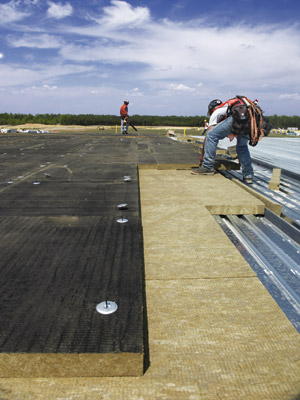 |
The Long-Term Thermal Resistance (LTTR) of roof insulation can be different from the laboratory performance due to many factors that can be mitigated based on the type of insulation used. Photo courtesy of ROXUL, Inc. |
R-Value Comparison: Stone Wool and Polyisocyanurate
With a general framework established for looking at R-values in insulation, let's look more closely at two specific types of insulation that are used for roofing applications, namely stone wool board and polyisocyanurate (polyiso) board insulation.
Insulation Characteristics
Polyisocyanurate is a commonly used insulation board, particularly for roofing. The trade association known as the Polyisocyanurate Insulation Manufacturers Association (PIMA) defines it as a closed-cell, rigid foam board insulation consisting of a foam core sandwiched between two facers. The facers are composed of various organic and inorganic materials, usually paper and fiberglass. It is widely used in residential and commercial markets for both roof and side wall applications. Among the characteristics that have contributed to its popularity is a comparatively high R-value per inch of thickness. In fact, it can currently claim to have the highest tested R-value per inch of any other commercially available insulation on the market. The foam core is moisture resistant, the board can achieve an FM Class 1 fire rating, it is widely available, and competes well on price.
By contrast, stone wool roofing insulation does not contain any foam plastics or blowing agents. Rather, it is manufactured out of volcanic basalt rock mixed with some recycled slag in a furnace. The melted rock is then literally spun into wool with minor amounts of organic binder and process additives to create the desired density of the end product as a rigid board. The stone wool fibers are typically non-directional which is important for achieving the multiple performance characteristics of the final product. In terms of R-value, stone wool provides very good performance, but most notably, that performance has been shown to remain constant over time. Since there are no blowing agents, there is nothing to out gas, meaning that the thermal performance does not change. It also has superior qualities in regard to fire resistance, dimensional stability, sound attenuation, and water repellency.
When looking to select or specify roofing insulation, architects and designers may first look at the published R-values of these two insulation products based on lab test results. Stone wool insulation, when tested under ASTM protocols at a mean temperature of 75°F (i.e. 50°F outside, 100°F inside) will yield an R-value of approximately R-4.0 per inch. However when tested at lower mean temperatures, such as 25°F (0°F outside and 50°F inside) that R-value has been shown to increase up to approximately R-4.4 per inch. Conversely, at higher mean temperatures, such as 110°F (135°F outside and 85°F inside) it tests at about R-3.7. These values may vary based on different products from different manufacturers, but the trends have been clearly established and are characteristic of the material.
R-values for polyisocyanurate insulation are similarly tested per ASTM standards at a mean temperature of 75°F. They are further tested per the LTTR method for a weighted average aged R-value. Most manufacturers now publish an R-value of R-5.7 per inch as a result of that testing. However, as far back as 2003, the National Roofing Contractors Association (NRCA) has performed independent testing of polyisocyanurate insulation, through a third-party laboratory, by using actual samples from different manufacturers. These tests were performed according to ASTM protocols and used the 75°F mean temperature as the basis. Additionally, the ASTM protocol also specifies, but does not require reporting, of testing samples at mean temperatures of 25, 40, and 110°F which the NRCA performed to see if there were any differences in R-value.
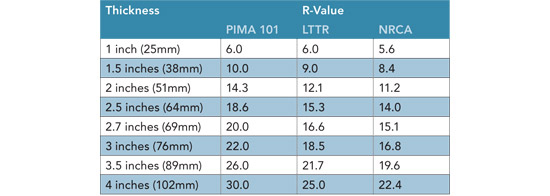 |
Comparison of R-values for faced polyisocyanurate insulation boards prior to JAN. 1, 2014. Chart courtesy of ROXUL, Inc., with permission from NRCA, PROFESSIONAL ROOFING magazine. |
This work has been carried out and reported in numerous articles and reports in Professional Roofing magazine and elsewhere. The NRCA testing concluded that there is indeed a difference based on temperature and there is a notable range in performance between manufactured products. Of note, it determined that as the mean temperature drops below 75°F, the R-value also drops down to an average low of about 4.75 at a 25°F mean temperature. Further, when the outdoor temperature gets above the 75°F mean, the R-value also drops below the R-6 value, which was claimed by polyiso manufacturers prior to January 1, 2014. These findings became the basis for the NRCA to recommend using a more representative value of R-5.6 per inch when designing for warm climates and R-5.0 per inch when designing for cold climates.
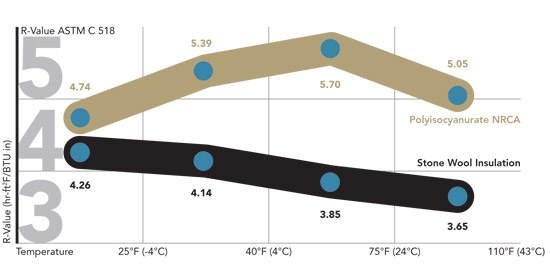 |
Compared to polyisocyanurate insulation, stone wool insulation thermal performance improves at cold temperatures and performs consistently at all temperatures. Graph courtesy of ROXUL, Inc. |
 |
Comparison of R-values for faced polyisocyanurate insulation boards after JAN. 1, 2014. Chart courtesy of ROXUL, Inc., with permission from NRCA, PROFESSIONAL ROOFING magazine. |
Independent Laboratory Testing
Separate from the NRCA studies, an independent organization known as Building Science Corporation (BSC) has conducted a series of similar tests on different thicknesses of polyisocyanurate insulation at different test temperatures that more closely replicate anticipated environmental conditions. Mean temperatures in the real world aren't governed by a 50°F temperature difference between inside and outside, so they conducted tests with a constant 72°F inside temperature and a variable outside temperature to generate the relevant mean temperatures.
On this basis, BSC first tested samples of 2-inch-thick polyisocyanurate insulation which had a commonly published LTTR aged R-value of R-12.1 or just slightly better than the R-6 per inch for a 1-inch sample. The NRCA doesn't differentiate between solid or stacked boards, so their 2 inch recommended R-value is simply twice the R-5.6 or R-11.2. All of the samples tested showed a decrease in R-values at winter outdoor temperatures below 32°F or summer solar heated roof temperatures above 113°F. Further, they determined that the change in performance is not linear across temperature changes meaning that it is very difficult to predict actual performance between tested temperatures. They also found that there was a notable variation in performance between manufacturers. In essence, this test agreed with the NRCA findings indicating that the design R-values should be reduced from the published values for more accurate calculations.
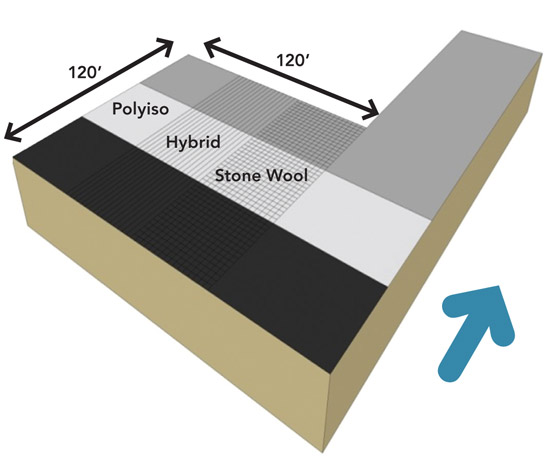 |
The RDH study looked at different roofing assemblies in place on the same building to compare performance. Source: “Monitored Field Performance of Conventional Roofing Assemblies – Measuring the Benefits of Insulation Strategy” by Marcus Dell, PEng, and Graham Finch, PEng, of RDH Building Engineering Ltd. The paper was presented at the RCI Symposium on Building Envelope Technology, November 2013. |
BSC went on to look at thicker 4-inch layers by stacking 2-inch layers of insulation and using the same test methods as previously. Once again, they found that the performance of the polyisocyanurate insulation declined as the outdoor temperature dropped. This led them to state the following recommendations for using this insulation in cold-temperature climates:
- Use thicker layers of polyisocyanurate insulation to ensure that the performance meets expectations—i.e. the actual R-values will likely be less than the published R-values.
- Use a hybrid insulation approach—install cold temperature-tolerant insulation over the top of polyisocyanurate insulation to increase the mean temperature of the polyisocyanurate.
Field Monitoring Study
In order to determine a more comprehensive understanding of the performance between stone wool and polyisocyanurate insulation used in roofing systems, RDH Building Engineering Ltd. in Vancouver, BC has undertaken a Field Monitoring Study. This ongoing work to be conducted over several years has looked at nine side-by-side roof insulation assemblies with variations in insulation make-up and roofing membrane color. The roofing variables consist of three different two-ply SBS membrane cap sheet colors placed over three different conventional insulation strategies (polyiso, stone wool, and a hybrid combination of both), creating a total of nine unique roofing assemblies (each 16 square, 1,600 ft2 in size) on the same building to study. The thickness of each insulation combination was varied to achieve approximately the same effective R-value in each assembly. Sensors were installed to measure temperature, relative humidity, moisture content, and heat flux at various points within each of the roof assemblies.
Among the findings observed to date:
- Both polyiso and stone wool exhibit a strong temperature-dependent thermal conductivity, though they behave differently at cold and hot temperatures. Since the stone wool does not rely on blowing agents for insulation performance, it demonstrates a more linear relationship between outdoor temperature and thermal performance. Further, the RDH study also observed that the thermal performance of stone wool improves with colder temperatures from standard conditions (75°F), whereas the performance of polyiso declines under both cold and hot conditions.
- A roof constructed with 3.5 inches of polyiso may have a code-acceptable calculated R-value of R-21.3, but when exposed to cold (14°F) would drop to R-20 or as low as R-16.5 depending on its age; and when exposed to hot (167°F membrane surface) temperatures would drop to R-16.5 or as low as R-14 depending on its age.
- In the hybrid assembly (4.5 inches thick), the use of a layer of stone wool insulation (in this case, equivalent to approximately 45 percent of the assembly R-value) over the top of the polyiso significantly improves the effective R-value of the polyiso as it keeps it near optimum temperatures (which are similar to typical interior temperatures); and therefore, results in a better assembly R-value in cold and hot conditions.
- The roof assembly insulated with entirely stone wool insulation (at 5.75 inches thick) will have a more stable R-value (increasing at colder temperatures and slightly decreasing at hot temperatures from calculated R-value), and is not susceptible to a loss of R-value with age.
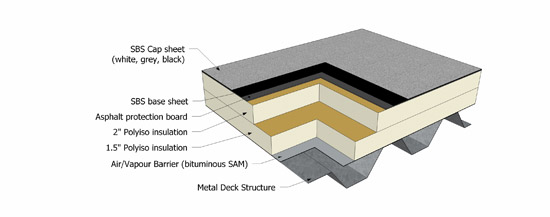 |
Polyiso Roof Assembly Image courtesy of RDH Building Engineering Ltd. |
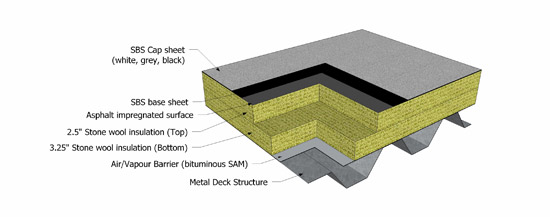 |
Stone Wool Roof Assembly Image courtesy of RDH Building Engineering Ltd. |
Based on the above, important considerations when designing roof assemblies include:
- Stone wool and hybrid roofs will maintain R-values close to calculated values, whereas the R-value in the roof with polyiso will drop a significant amount when exposed to cold or hot outdoor (and solar radiation induced) temperatures.
- The higher heat capacity of stone wool insulation reduces the peak membrane temperature, which is positive for the longevity of the membrane and reduces the peak interior temperature, which is a positive for the occupants.
- Stone wool has a more stable R-value than polyiso so it insulates better when exposed to larger temperature differences.
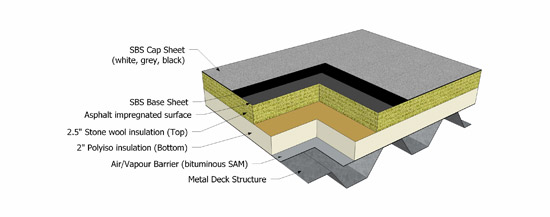 |
Hybrid Stone Wool & Polyiso Roof Assembly Image courtesy of RDH Building Engineering Ltd. |
The overall conclusion that can be drawn from all of this collective work is that climate and location matter when selecting roofing insulation. The use of insulation that does not perform as expected will likely increase the actual energy consumption within buildings in both cold and hot climates. This is an important consideration to overall performance and will be a factor when sizing mechanical equipment as well. Climate driven R-values, based on the mean temperature between indoor and outdoor conditions, need to be accounted for in design.
Beyond R-Values: Other Considerations
While the significance of R-value is high, there are also other characteristics to consider when selecting the best insulation for a particular location and climate.
Moisture Content
There is a common misperception that stone wool insulation is moisture sensitive. In reality, stone wool acts as a hydrophobic material and is water repellent yet vapor permeable. This means that the insulation does not absorb or hold moisture so the R-value and other physical properties are not affected by water exposure as with some insulation such as fiberglass. The permeability means that the material is breathable so no double vapor barrier or trapped moisture issues arise. Further, being water-repellent also means that stone wool insulation does not promote rot, corrosion, fungi, mold, or bacterial growth.
One of the special properties of stone wool is the non-directional orientation of the material, making it ideal for repelling and draining water away from the exterior walls, industrial pipe, interior walls, or whatever the insulation is protecting. Similarly, an important benefit of the insulation is its ability to allow trapped vapors in a roof or wall assembly to disperse throughout the insulation layer. Hence, water exposure from leaks in a membrane or from condensation within the assembly can be removed by allowing the insulation to vent this moisture. Stone wool will quickly dry out to become fully restored and retain its original characteristics.
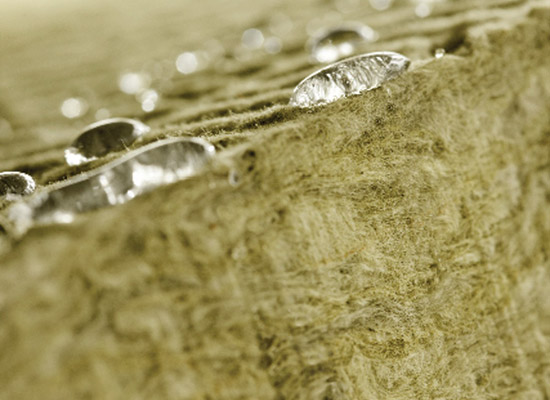 |
Stone wool insulation board will repel bulk water and disperse water vapor while foam insulation can trap moisture in the assembly. Image courtesy of ROXUL, Inc. |
John Straube, Ph.D., P.Eng., of the Building Science Corporation, has noted from their research: “Stone wool is hydrophobic and water repellent. It sheds water like water off a duck's back because of oils and resins in the stone wool itself so it actually is highly water repellent.” They have further noted, “The normal comparison to stone wool insulation would be some types of foam insulation. If the design is not taking into account the vapor-resistant properties of foam, you can trap moisture in a roof or a wall assembly. And of course, trapped moisture leads to damage such as mold growth, corrosion, or decay.”
In the RDH (Dell/Graham) field study, the researchers found that “water vapor moves within stone wool insulation more readily than polyiso insulation resulting in greater accumulations during periods of high and low temperature. This means that with stone wool insulation there is the potential for more water vapor redistribution with the roof system in the event of a leak.” In other words, the permeability of the insulation allows moisture to move and may help to keep other materials dry. Some further independent testing from the Fraunhofer Institute in Boston shows that stone wool insulation R-values remain stable even with water content up to 3.1 lb/ft3 (50 kg/m3). In all, these findings indicate that stone wool isn't affected by moisture, in fact it helps dissipate it. In the process the R-value of the insulation is maintained while the product remains stable and durable as well.
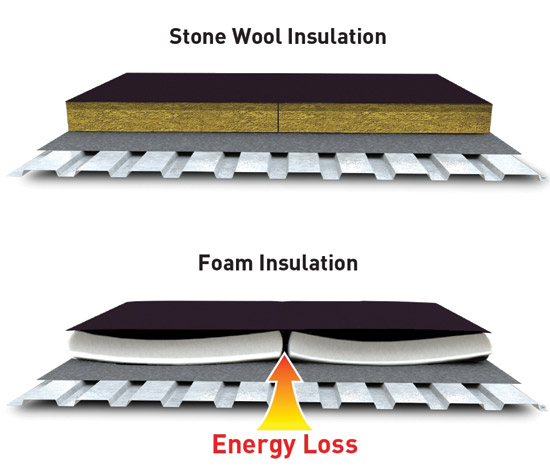 |
Dimensionally stable stone wool insulation board prevents warping and gaps which promote energy loss. Image courtesy of ROXUL, Inc. |
Dimensional Stability
The term dimensional stability is generally defined as the material's ability to retain its original shape when subjected to external forces such as varying degrees of temperatures, atmospheric pressures, moisture content, and/or other external stresses. Dimensional stability in relation to thermal insulation is a physical characteristic that is sometimes overlooked when a designer or specifier is determining which type of insulation to use for a project, particularly on roofing applications. Neglecting the dimensional stability characteristics can potentially result in the reduction of the effective R-values, increased energy costs, increased environmental impacts (CO2), and the unexpected replacement of building materials due to stress and fatigue.
The dimensional stability of an insulation material is necessary for the faultless function of an insulation system. Dimensional changes in materials vary according to their physical properties. Thermal expansion coefficients express the rate at which materials shrink or expand when cooled or heated. Stone wool insulation has a much smaller thermal expansion coefficient than organic insulation materials such as foam plastics. Poor dimensional stability can cause shrinking, expansion, and buckling of a system's insulation. These actions can lead to thermal bridging, waterproofing breaches, and unpredictable insulation performance.
The most common dimensional change in building materials is created by temperature variation. In thermal insulation, the rate of this dimensional change due to temperature variation is based on three factors: the difference in temperature (ΔT), the coefficient of linear expansion (α), and the material length (l). Using these variables, stone wool insulation has been shown to move dramatically less when compared to the same sized common organic plastic insulation boards. Stone wool is also much closer to the coefficient of expansion of steel and concrete than the plastics, meaning that it will move more closely in line with those materials.
The other common dimensional change in many insulation products occurs due to aging. The molecular structure of foam insulation is initially unstable for a period of time after manufacturing and so there is high potential for shrinkage to occur. As this shrinkage is deemed to be an “acceptable practice” within the roofing industry, ASTM D2126 Test Method for Response of Rigid Cellular Plastics to Thermal and Humid Aging allows for a maximum shrinkage of 2 percent (length and width). In theory, this will reduce the insulation footprint covering a roof deck by 2 percent, thus allowing for increased heat loss and leaving the roofing membrane unsupported along insulation joints which increases the potential for damage. By contrast, studies have proven that stone wool insulation maintains its dimensions and its physical characteristics throughout a building's life cycle. By maintaining the material's original dimensions, full thermal insulation coverage is maintained and the roofing membrane service life is extended due to a lack of unnecessary stress and or fatigue.
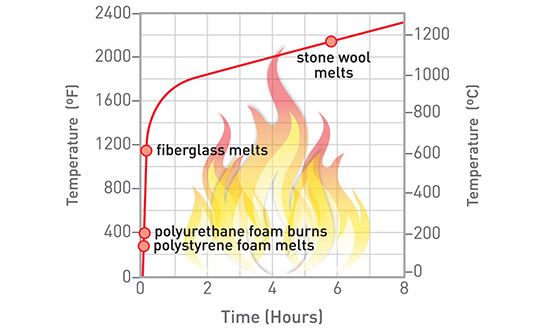 |
Comparative temperature development in a standard ASTM E119 fire test showing melting or burning points of foam insulation compared to stone wool insulation. Chart courtesy of ROXUL, Inc. |
Fire Resistance
Fire resistance describes how well a building component can—for a stated period of time—hold back fire and prevent it from penetrating from one room to another. The basic criteria used to characterize the fire resistance of a product are flame spread, smoke development, and non-combustibility. Because of its stone and slag makeup, stone wool excels in all three of these criteria. It will not develop toxic smoke or promote flame spread, even when directly exposed to fire, as some other insulation materials do. When tested in accordance with ASTM E 84 stone wool typically shows a flame spread of 0 and a smoke development of 0. By comparison, spray polyurethane foam [SPUF] tested to ASTM E 84, typically achieves a flame spread of 25 and smoke developed in the 350 to 500 range.
Beyond these basic fire resistance properties, stone wool insulation has an impressive ability to withstand temperatures up to its melting point of approximately 2,150°F (1,177°C). Photo #7 As such, it can act as a fire barrier, when used in conjunction with appropriate fire sealant materials, thus helping to prevent the spread of fire and potentially providing valuable extra minutes to save people and property. This is in contrast to other insulation materials and many other building materials.
Since stone wool insulation does not contribute to fire propagation, it may provide additional escape time to occupants. It may also provide fire services personnel with additional time to both clear occupants, and control the spread of fire while delaying the collapse of various structural members of the building. As a result, architects should take into account the added value of passive fire resistance which can be achieved by using stone wool insulation in buildings.
Insulation for Acoustical Control
Acoustical control has become a growing concern in buildings of all types, particularly in school, healthcare, and office settings where people are trying not to be distracted by unwanted noise. There are a number of references and standards available to help determine acceptable background noise levels but it is incumbent on the building designers to focus on achieving them by restricting unwanted sound from entering the spaces. This means creating wall, floor, and roof components or assemblies that effectively control the amount of airborne sound transmitted through them. The measurement for this effectiveness is determined by a Sound Transmission Class (STC) rating. A higher STC rating means that more airborne sound is blocked by the component or assembly. Lower STC ratings mean that more sound passes through the components or assemblies, adding to the background noise level in the space, degrading the ability to hear and understand speech, and leading to occupant discomfort.
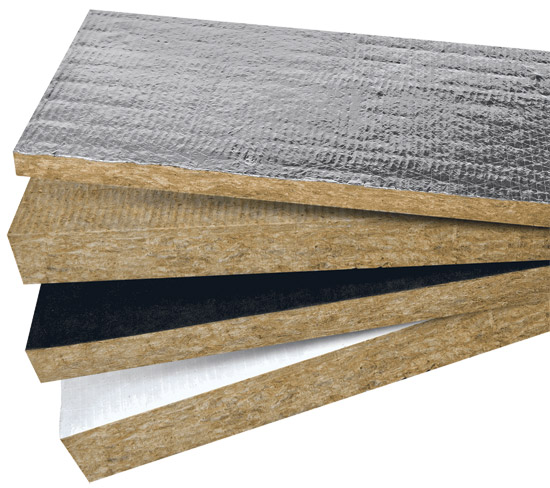 |
Different thicknesses of stone wool insulation can be used in buildings to improve acoustic performance. Image courtesy of ROXUL, Inc. |
It should be noted that, contrary to the popular notion that sound passes through a structure, such is not always the case. Sound generated on one side of a wall will energize the wall structure and set it in motion, much like a diaphragm. The wall itself becomes the transmitter of the sound energy which can be heard on the opposite side of the wall by the listener. Hence, the ASTM test methods used to determine STC ratings have focused on this direct transmission process, although this testing has changed over the years meaning that STC results posted before 1999 may not produce the same results today.
Currently, the STC number is derived from sound attenuation values tested at 16 standard frequencies from 125 Hz to 4,000 Hz. The measurement is accurate for speech sounds but less so for amplified music, mechanical equipment noise, transportation noise, or any sound with substantial low-frequency energy below 125 Hz. Therefore, as a supplement to STC ratings, the Outdoor-Indoor Transmission Class (OITC) is a standard that is weighted more to lower frequencies (down to 80 Hz) used for indicating the rate of transmission of sound between outdoor and indoor spaces in a structure (i.e. aircraft / rail / truck traffic).
At least one significant research study by G. W. Evans & Maxwell considered students at a school in the regular flight path of an airport. After taking into account variables such as socioeconomic status, students in that school performed as much as 20 percent lower on a reading test than students in another nearby school, indicating a strong correlation between sound levels and learning.
When looking at roof assemblies, the insulation used can make a notable difference in reducing the amount of noise that is transmitted through the roof structure. Engineer John Straube of BSC has addressed this in their work and found that “foam plastic insulations typically used in (low slope) roofs have relatively poor acoustic performance. Stone wool insulation used, even as only part of that low slope roof package can make a dramatic difference in reducing sound transmission. And this has lots of practical value near airports or any other place where lots of sound can come from above.” These comments are based on the fact that the higher density of stone wool insulation compared to other insulation materials means higher acoustical resistance is achieved. Further, the non-directional fiber orientation of the stone wool helps with the absorption of acoustic waves and can reduce the intensity and propagation of noise. These denser structures, coupled with tight, seamless joints create effective barriers to noise and contribute to much quieter and safer work environments. The case studies in this article present two excellent examples of this performance.
Ridgewood High School, Norridge, IL |
|
Re-roofing of Ridgewood High School Significantly Reduces Low Frequency Aviation Noise from Chicago O’Hare Airport Although Ridgewood High School has served the Chicago suburb of Norridge for over six decades, the airplane noise only became a problem a few years ago when flight patterns in and out of O’Hare changed. Due to glazing that inadequately isolated sound isolation, the make-up of the original roof assembly and a lack of air conditioning that required open windows in some classrooms, the exterior envelope of the school was incapable of keeping aircraft noise out of the classrooms. “The noise can be so bad the teachers sometimes have to stop in mid-sentence,” said Arturo Benitez of DLA Architects, who is overseeing the Ridgewood High School construction project designed to keep noise from making its way into the classrooms serving Ridgewood’s 900 students. Increased flight volumes at airports across the U.S. prompted the federal government to fund a $220 million project dedicated to helping insulate high-impact facilities against sound interference. Ridgewood qualified because octave band noise testing confirmed that measured noise levels exceeded the 45 dbA maximum acceptable level included in ANSI S 12.60 for schools, LEED® for Schools 2009 and Federal Aviation Administration guidelines for Type 4 buildings (schools). Thus, the school was included in the Chicago Department of Aviation’s School Sound Insulation Program for communities surrounding O’Hare and became eligible for federal sound remediation construction funding to bring decibel levels within FAA guidelines. After considering a variety of options, Benitez and his sound consultant, Laurie Kamper of Threshold Acoustics, determined that a roof assembly that featured alternating layers of exterior gypsum boards and stone wool insulation would achieve the desired sound attenuation levels. The new roof assembly is layered as follows (bottom to top):
Importantly, by changing the materials above the roof deck the interior of the building’s ceiling structure has remained intact, allowing for ongoing construction while classes were in session. The 2011 published results of third party testing of the assembly confirmed that the construction was ideal for the project. It was the first gypsum roof board assembly tested to contribute to Sound Transmission Class (STC) ratings of up to 61 and Outdoor Indoor Transmission Class (OITC) ratings of up to 49 in roofing assemblies for commercial framed construction. The stone wool insulation demonstrates superior sound reduction characteristics as its non-directional fiber orientation helps to trap and dissipate sound waves. The product also has a higher density top layer providing strong point-load resistance and effective load distribution. The product maintains a stable R-value over time, is dimensionally stable and won’t shrink or off-gas blowing agents into the environment. The fiberglass mat gypsum roofing cover board features a combination of fire resistance, strength, dimensional stability and ease of installation. The mass of the gypsum core acts as a barrier to sound transmission and has been tested to show superior sound mitigation properties. Also, both gypsum and stone wool products are non-combustible, providing added fire resistance and safety to the building structure. Combined with other sound remediation enhancements—such as enclosing the rooftop duct system and AV units; adding extensive amounts of stone wool for interior stud walls and roof duct enclosures; adding laminated, tempered glass windows; and installing acoustically-rated door systems in certain areas—the new roof at Ridgewood is already making a significant impact in the classroom. |
Flynn Canada, Etobicoke, Ontario |
|
Architect: Geza Tormasi- Associate with Glenn Piotrowski Architect Ltd. Project Timeline: 2010-2011 Project Size: 82,000 square feet Flynn Canada is a trade contractor of complete building envelope solutions. With 17 offices from coast-to-coast they manage single facilities, as well as organizations with national real estate portfolios. When the company needed to expand its own real estate, by turning a warehouse into office space, the noise inside the building from the nearby airport needed to be addressed. A re-roof was needed over the office space portion of the building. Valcoustics, an acoustical consulting company, performed acoustical testing on the building before and after the re-roof to assess the difference in noise transmission frequencies. Insulation solution: A rigid stone wool insulation board with dual density properties was specified based on its higher density top layer providing strong point load resistance and effective load distribution. Further, the stone wool met the project requirements to be fire resistant, water repellent, sound absorbent, sustainable and provide a long term stable R-value. Roof Assembly (top to bottom):
Results: Stone wool insulation was successfully used over existing materials to retrofit the roof for noise reduction. The insulation demonstrates superior sound reduction characteristic and improved low frequently sound absorption to both normal and random incidents of noise. The non-directional structure is denser than traditional insulations which effectively reduces airflow and sound transmissions for excellent sound reduction. According to the sound consultant, “Substantial improvement in the indoor acoustical environment was achieved. Outdoor sound levels due to the aircraft flyovers were reduced by up to 39 dB.” They went on to point out “Based on the same sound level at the roof for the pre and post renovation condition, the indoor NC level has been reduced from NC 61 to NC 39 with the indoor sound level dropping from 58 dBA to 45 dBA. This reduction is a direct result of the roof upgrade, which included the addition of the stone wool 2.5 inch insulation.” Meetings are no longer interrupted by airport traffic noise due to 13 dB noise reduction after re-roof. |
Conclusion
There are a number of factors to consider when determining performance of insulation in buildings:
Climate zone. The thermal performance of insulation has been shown to vary at different temperatures. Stone wool improves at lower temperatures while foam polyisocyanurate insulation loses performance at low temperatures due to aging, dimensional instability/gaps, and lower temperature performance. It is important to recognize and use the most relevant R-values for design, energy modeling, construction, and operational performance.
Blowing agents. Polyisocyanurate insulation materials use blowing agents to provide thermal performance which diffuse from the product over time. Stone wool does not contain blowing agents.
Thermal expansion coefficients. Different insulation materials have different expansion & contraction rates due to changes in temperature and these changes result in permanent deformations. Foam plastics have a much larger rate of expansion and contraction than stone wool. Foam insulation boards can leave significant gaps in the thermal layer where stone wool remains stable and virtually unaffected.
Moisture and fire resistance. Stone wool provides strong performance in both of these areas particularly when compared to other types of insulation.
Acoustics. Some insulation materials will perform better than others when installed in buildings for many of the same reasons they perform better for thermal control applications. Stone wool insulation has been shown to provide excellent acoustic control.
When an insulation product can be selected to meet all of these design criteria, then it has the highest likelihood of contributing to a successful design solution with long-term sustained performance.
 |
ROXUL Inc. is a subsidiary of ROCKWOOL International, the world’s largest producer of stone wool insulation. ROCKWOOL International is a publicly held company, which trades on the Copenhagen Stock Exchange. Operating 27 factories worldwide, the Rockwool Group employs over 9,800 people and features a global network of sales companies, trade offices, and dedicated commercial partners. ROXUL products are thermally efficient, non-combustible, sound absorbent, water repellent, non-corrosive, and are resistant to mold, fungi, and bacteria growth. For more information on ROXUL commercial products, please visit www.rspec.com. |
